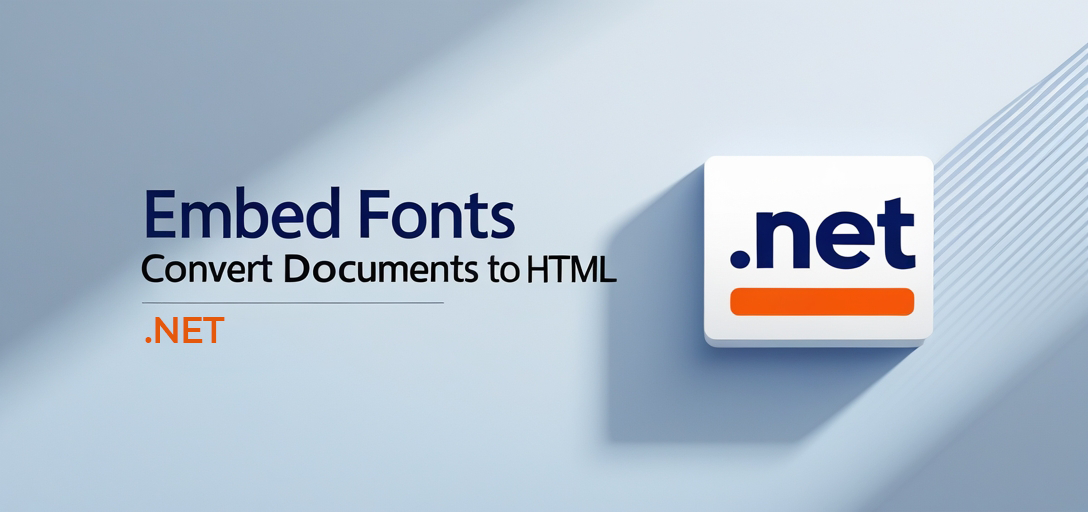Mastering Document Rendering with GroupDocs.Viewer .NET: Embed Fonts and Convert to HTML
Introduction
In the digital era, seamless document rendering is essential for businesses that need dynamic content presentation across various platforms. Whether you’re a developer working on cross-platform applications or managing internal document workflows, ensuring consistent font rendering and efficient document conversion can be challenging. This tutorial addresses these challenges by using GroupDocs.Viewer .NET to detect fonts paths based on operating systems, configure font sources, and render documents into HTML with embedded resources.

In this guide, you’ll learn how to:
- Detect and set appropriate font paths for different OS platforms
- Configure font sources using GroupDocs.Viewer .NET
- Render documents into HTML format with all necessary resources embedded
By the end of this tutorial, you’ll have a robust understanding of setting up and utilizing these features effectively in your .NET applications. Let’s start by looking at the prerequisites needed.
Prerequisites
Before we proceed, ensure that you have the following:
- Libraries & Dependencies: GroupDocs.Viewer for .NET version 25.3.0
- Environment Setup: A development environment with .NET installed (preferably .NET Core or later)
- Knowledge Base: Basic understanding of C# programming and familiarity with file system operations
Setting Up GroupDocs.Viewer for .NET
To begin, you’ll need to install the GroupDocs.Viewer library. You can do this via NuGet Package Manager Console or using the .NET CLI:
NuGet Package Manager Console
Install-Package GroupDocs.Viewer -Version 25.3.0
.NET CLI
dotnet add package GroupDocs.Viewer --version 25.3.0
License Acquisition
- Free Trial: Start by downloading a free trial from the GroupDocs website.
- Temporary License: Apply for a temporary license to access full features without limitations at GroupDocs Temporary License page.
- Purchase: For long-term use, consider purchasing a license from the GroupDocs Purchase page.
Basic Initialization
Here’s how you can initialize GroupDocs.Viewer in your C# application:
using GroupDocs.Viewer;
// Initialize Viewer object with document path
using (Viewer viewer = new Viewer("sample.docx"))
{
// Configuration steps go here
}
Implementation Guide
In this section, we’ll explore each feature step-by-step. Our focus will be on detecting font paths, configuring fonts, and rendering documents.
Detecting Fonts Path Based on OS Platform
Overview
This feature automatically determines the path for font files based on whether you’re running your application on Windows or a non-Windows platform. It’s crucial for ensuring that text is rendered accurately across different environments.
Step-by-Step Implementation
1. Check Operating System
using System;
using System.IO;
using System.Runtime.InteropServices;
public static string GetFontsPath()
{
// Determine the OS platform and set the fonts path accordingly
if (RuntimeInformation.IsOSPlatform(OSPlatform.Windows))
{
return Utils.FontsPath; // Preset path for Windows platforms
}
else
{
var assembly = System.Reflection.Assembly.GetEntryAssembly();
var entryAssemblyDirectory = Path.GetDirectoryName(assembly.Location);
return Path.Combine(entryAssemblyDirectory, Utils.FontsPath); // Derived path for non-Windows
}
}
Explanation: This method uses RuntimeInformation.IsOSPlatform to check if the application is running on Windows. If true, it returns a predefined fonts path (Utils.FontsPath). For other platforms, it constructs the path by combining the entry assembly directory with the fonts path.
Setting Font Sources for Document Rendering
Overview
Once we have determined the correct font path, the next step is configuring these paths in GroupDocs.Viewer so that it can use them during document rendering.
2. Configure Fonts Path
using GroupDocs.Viewer.Fonts;
public static void ConfigureFontSources(string fontsPath)
{
// Set the folder containing fonts as a source for rendering
FontSettings.SetFontSources(new FolderFontSource(fontsPath, Fonts.SearchOption.TopFolderOnly));
}
Explanation: This method creates an instance of FolderFontSource with the determined font path. It then sets this source using SetFontSources, ensuring that GroupDocs.Viewer uses these fonts when rendering documents.
Rendering Document to HTML with Embedded Resources
Overview
The final piece is converting your document into a web-friendly format, ensuring all resources are embedded directly within the output files for easier distribution and viewing.
3. Render to HTML
using GroupDocs.Viewer;
using GroupDocs.Viewer.Options;
public static void RenderDocumentToHtml(string documentPath, string outputDirectory)
{
// Define how each page of the HTML will be stored
string pageFilePathFormat = Path.Combine(outputDirectory, "page_{0}.html");
using (Viewer viewer = new Viewer(documentPath))
{
HtmlViewOptions options = HtmlViewOptions.ForEmbeddedResources(pageFilePathFormat);
viewer.View(options); // Render document with embedded resources
}
}
Explanation: This code initializes a Viewer object and sets up HTML view options to include all necessary resources (such as fonts, images) directly within the output HTML files. The ForEmbeddedResources method ensures that these are self-contained.
Troubleshooting Tips
- Font Not Displaying Correctly? Ensure that your font paths are correctly set for each platform.
- Performance Issues: Consider optimizing file sizes and reducing embedded resources where possible.
- Rendering Errors: Verify the document path and ensure it’s accessible by the application.
Practical Applications
- Internal Document Management: Use this setup to render internal documents as web pages, facilitating easier access across different departments.
- Client Presentations: Convert client proposals or contracts into HTML for easy sharing over email or on intranets.
- Web Portals: Embed documents directly into web applications without requiring additional downloads.
Performance Considerations
- Optimize Font Paths: Use relative paths to minimize load times and ensure that fonts are correctly accessed across different environments.
- Resource Management: Regularly review embedded resources within your HTML files to prevent bloating, which can slow down rendering speeds.
- Memory Optimization: Utilize
usingstatements effectively to manage memory usage by disposing of objects promptly after use.
Conclusion
By integrating GroupDocs.Viewer for .NET into your applications, you’ve unlocked a powerful toolset for document management and presentation. This tutorial has equipped you with the knowledge to detect font paths based on operating systems, configure font sources, and render documents efficiently as HTML with embedded resources.
As next steps, consider exploring more advanced features offered by GroupDocs.Viewer or integrating this functionality into larger projects. Don’t hesitate to experiment with different configurations to find what best suits your needs.
FAQ Section
- How do I handle non-standard fonts?
- Ensure they are included in the font source directory and correctly referenced in
Utils.FontsPath.
- Ensure they are included in the font source directory and correctly referenced in
- What if my application runs on a Unix-based system?
- The code already handles this by deriving the path from the entry assembly directory.